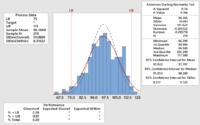You are using an out of date browser. It may not display this or other websites correctly.
You should upgrade or use an alternative browser.
You should upgrade or use an alternative browser.
A Question on Probability
- Thread starter Sarmmer
- Start date
From summary data, it is impossible to get an exact answer because information is lost in summarization.
Your estimate of approximately 0.00006% is, as you suspected, too low because you are assuming that the only way to get a sum below 300 is for all four products to be below 75. But that is not the case. You can get better estimates by making some assumptions.
What is the probability that all four are 75 or more?
What is the probability that one is less than 75 and one is is at least 80 on the assumption of normal distribution?
What is the probability that two are less than 75 and one is is at least 85 on the assumption of normal distribution?
What is the probability that three are less than 75 and one is is at least 90 on the assumption of normal distribution?
Add those up. Call that g.
I claim that the probability of a sum of 300 or more is greater than g. How do I justify that claim?
Let b equal the probability that the sum is less than 300.
[MATH]\therefore 0.0228^4 < b < 1 - g.[/MATH]
Why?
Your estimate of approximately 0.00006% is, as you suspected, too low because you are assuming that the only way to get a sum below 300 is for all four products to be below 75. But that is not the case. You can get better estimates by making some assumptions.
What is the probability that all four are 75 or more?
What is the probability that one is less than 75 and one is is at least 80 on the assumption of normal distribution?
What is the probability that two are less than 75 and one is is at least 85 on the assumption of normal distribution?
What is the probability that three are less than 75 and one is is at least 90 on the assumption of normal distribution?
Add those up. Call that g.
I claim that the probability of a sum of 300 or more is greater than g. How do I justify that claim?
Let b equal the probability that the sum is less than 300.
[MATH]\therefore 0.0228^4 < b < 1 - g.[/MATH]
Why?
Last edited:
From summary data, it is impossible to get an exact answer because information is lost in summarization.
Your estimate of approximately 0.00006% is, as you suspected, too low because you are assuming that the only way to get a sum below 300 is for all four products to be below 75. But that is not the case. You can get better estimates by making some assumptions.
What is the probability that all four are 75 or more?
What is the probability that one is less than 75 and one is is at least 80 on the assumption of normal distribution?
What is the probability that two are less than 75 and one is is at least 85 on the assumption of normal distribution?
What is the probability that three are less than 75 and one is is at least 90 on the assumption of normal distribution?
Add those up. Call that g.
I claim that the probability of a sum of 300 or more is greater than g. How do I justify that claim?
Let b equal the probability that the sum is less than 300.
[MATH]\therefore 0.0228^4 < b < 1 - g.[/MATH]
Why?
What would the best method to evaluate based on the raw data instead of summarized data?
Is the below method appropriate in calculating it (column in bold)?
with p = 2.28%, q = 97.72%, the probability to get befow 300g when taking 4 samples randomly is 0.00003%.
The figure i mention to be weird previously because i calculated based on the method below (red text), where the sum of probability is not 100%.
| n | n! | (n-x) | (n-x)! | x | x! | Probability = n!/[(n-x)!x!]*pxq(n-x) | pxq(n-x) |
| 4 | 24 | 4 | 24 | 0 | 1 | 0.00003% | 0.00003% |
| 4 | 24 | 3 | 6 | 1 | 1 | 0.00463% | 0.00116% |
| 4 | 24 | 2 | 2 | 2 | 2 | 0.29784% | 0.04964% |
| 4 | 24 | 1 | 1 | 3 | 6 | 8.51031% | 2.12758% |
| 4 | 24 | 0 | 1 | 4 | 24 | 91.18719% | 91.18719% |
| Total | 100.00000% | 93.36559% |

